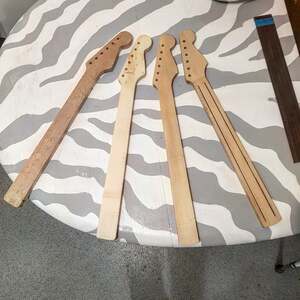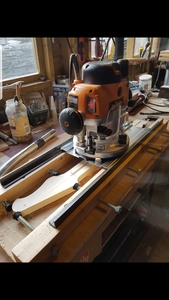I was wondering if anyone had any good sources for carbon stiffening rods for guitar necks. It's surprisingly difficult to find anything suitable.
Guitar suppliers seem to be mostly focusing on fairly hefty stuff (possibly more for truss rod replacement than additional stiffening), with the exception of stewmac, and they are all charging a really hefty premium.
carbonfibreprofiles.com do 4mm square (same as Crimson use in their necks apparently) at a good price (1m is £8.74), but their minimum delivery charge is £15, so unless I buy in bulk (I could order up to 15kg for that much, which would be a lot of guitars!) it's not optimum.
A lot of model suppliers do carbon fibre, but it tends to be round rod or square tube, not square (or rectangular) rod.
So, any suggestions?
Thanks
Interesting, what's your method for cutting the slots (seems a bit narrow for a router)?
My Triton Router works fine.
2mm cutter with 1/4" 6mm shank.
Due to machine vibration, you will always get a little clearance above the 2mm (you could use any thickness) required - just right for accommodating epoxy.
Careful of dust and shards when sanding!!!!
I use to strips + Truss Rod in Bass Necks, or in
6 + stringed guitars that have heavy gauge strings.
That‘s interesting, I never would have thought of a 2 mm wide strip but it makes sense. Just like a board, lay it flat and it bends like a saw blade but up on its edge, stiff as err, morning wood? 😂
Practice on scrap...
Be very careful when introducing cutter into wood and don't cut more than 2mm per run.
My Router runs on a guide/sled which makes it more secure than running along the edge. Adjustable arms hold/clamp the workpiece in relation to cutter that is always central.
You can cut channel to run true with Neck taper, or parallel to centre line.
Always have a clear centre line and all will be fine.
I couldn't possibly comment! But you're not wrong!
Nice jig.
Is there a reason you choose to shape the outline of the neck before routing for carbon and trussrod?
To prove the point.
Now it's routine.
Flat Blanks get to dry out for a few years after felling/sawing/planing (i plane close grain woods oversize when green) in open air then later into dry room @ 45% humidity.
Anothet 6mths to a year after which they get levelled profile cut and routed.
Another few months then final levelling, thicknessing, truss rod and fretboard fitted.
Each process allows me to gauge stability of the wood.
Done in batches it's quite efficient
I don't know what timescale they do it over, but I know PRS let their necks sit for a period after each stage of shaping so they can assess how they move and fix any issues.
I just looked at your facebook page, you have some very cool grain patterns on your bodies.








